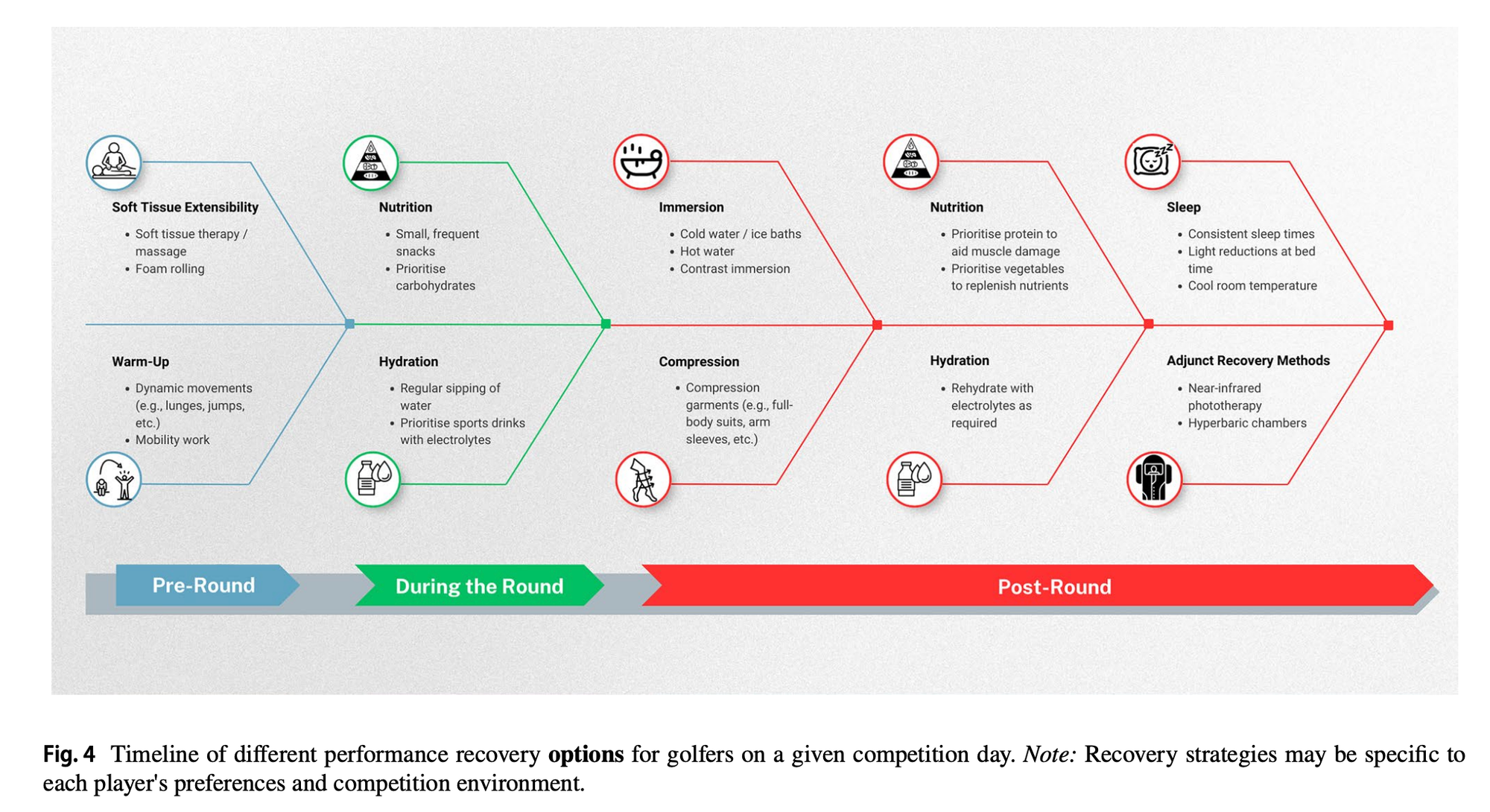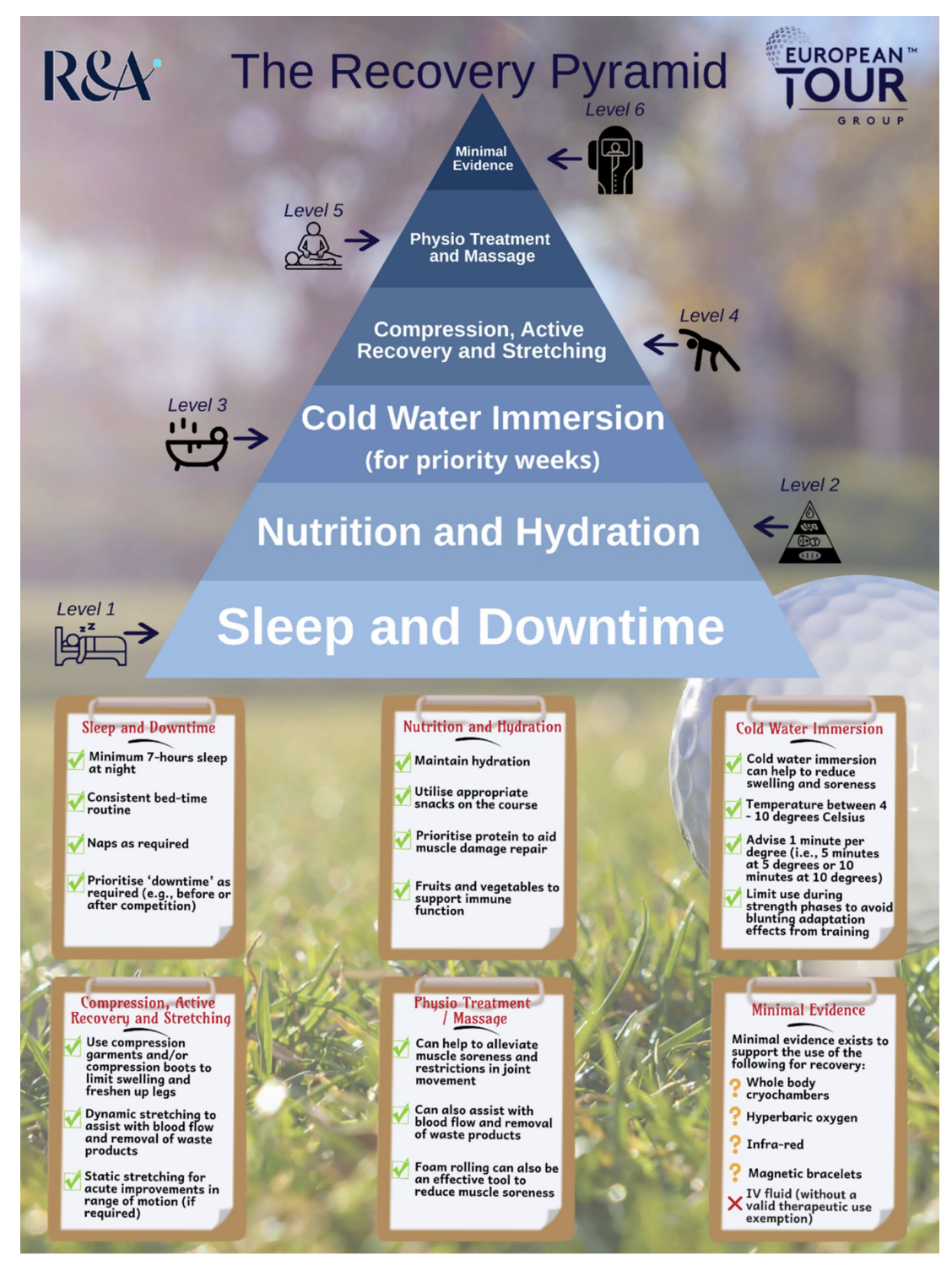Golfers endure unique demands: up to 2,000 swings in a tournament week, walking 40–80 km, and frequent travel across time zones.
Recovery isn’t optional; it has a direct impact on both performance and longevity.
This new scoping review mapped out recovery strategies for pro and elite amateur golfers and highlighted what actually helps.
Which recovery strategies make a real difference for golfers week to week?

What the Researchers Did
The researchers searched 5 databases (2000–2024) and and included 47 relevant studies. They focused on five key areas:
- Sleep
- Travel/jet lag
- Nutrition/hydration
- Controlled methods (massage, cold)
- Independent methods (mobility, compression, cognitive)
- Adjunct options (infrared, sauna, hyperbaric)
Recovery Interventions
Master Performance Coaching & Elevate Your Career in Just 6 Weeks with a Global Community of Professionals
Sleep is the Cornerstone
- A consistent schedule is critical
- Cool, dark room and limited evening caffeine/screens
- Short naps when needed
- Supports motor output and decision-making
Travel & Jet Lag
- Differentiate travel fatigue vs. true jet lag
- Sunday-night “reset” after tournaments
- Manage light and meal timing
- Hydrate on flights, move often, use electrolytes
Nutrition & Hydration
Remember the 3 R’s for nutrition:
- Rehydrate: ~1.5 L per kg lost
- Repair: 20–40 g protein
- Restore: carbs + fruit for liver glycogen
- Evening protein supports overnight recovery
Cold Strategies
- Cold-water immersion (~10 °C × ~11 min) helps reduce soreness in hot or high-volume weeks
- Avoid right before/after heavy lifts if adaptation is the goal
Massage & Mobility
- Massage aids relaxation and perceived recovery
- Static stretching/foam rolling improve flexibility and reduce soreness
- Warm-up remains essential for power, not static stretching
Compression Garments
- May reduce DOMS and muscle damage markers in general sports
- Golf-specific impact is minimal; mostly preference-based
Cognitive Recovery
- Pro golf is mentally taxing
- Downtime, naps, meditation, and social connection help
- Some venues now add mental health and relaxation spaces
Adjuncts
- Infrared, sauna, hyperbaric: promising but limited evidence in golf
- Use selectively; avoid heat between rounds in hot conditions
This figure summarizes different performance recovery on competition day:

What This Means
- Build from the base: Sleep and nutrition are the foundation
- Travel-smart: Sunday reset, hydration, mobility after landing
- Hot/hard weeks: Use short cold-water immersion strategically
- Tools are extras: Massage, mobility, compression, and adjuncts can help but aren’t the main drivers
Limitations
- Few golf-specific trials—much is extrapolated from broader sport science
- Varied methods/outcomes limit precision on exact protocols
- Adjunct modalities lack consistent evidence
Coach’s Takeaway
- Guard sleep like a skill—dark, cool, consistent
- Use the 3 R’s after every round: Rehydrate, Repair, Restore
- Plan for travel: light/meal timing, hydration, mobility
- Add cold immersion in hot or heavy weeks
- Use massage and mobility for feel and relaxation, not power boosts
This pyramid summarizes a recovery nicely:

I hope this helps,
Ramsey
Reference: Bishop C, Xu J, Wilson L, et al. (2025). Recovery for Professional and Elite Amateur Golfers: A Scoping Review of Evidence-Based Methods. Sports Medicine. Access fill text here.




